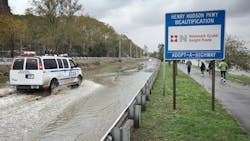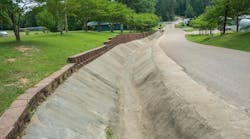New York City announces next generation of investment in flood prevention and preparation
New York City Mayor Eric Adams updated New Yorkers on September 9, 2024, on new and ongoing efforts to protect public safety and New Yorkers’ property by combating flooding and safeguarding the residents of New York City from the harmful and costly impacts of climate change.
Since the start of the current administration, the city has invested more than $1.2 billion in vital anti-stormwater flooding, public safety infrastructure in all five boroughs, ranging from traditional sewer upgrades to innovative green infrastructure solutions and more.
The city has also made similar investments in anti-flooding infrastructure that have been shown to prevent seven times as much damage as compared to the original investment, according to a press release.
Over the course of the Adams administration, the city has installed dozens of miles of new sewers, significantly upgrading the system’s drainage capacity to handle millions of additional gallons of sudden and heavy rainfall during a storm.
Additionally, the New York Department of Environmental Protection (DEP) is installing slotted manhole covers that provide an alternate drainage point to help street level water drain into curbside catch basins in the event that a catch basin grate gets matted over with leaves, debris or litter.
The city’s cloudburst program manages extreme downpours using localized grey and green infrastructure, open spaces and other innovative methods of absorbing, storing and transferring stormwater.
This summer, the city broke ground on the first of these projects at NYCHA’s South Jamaica Houses, projected to be completed in 2025.
The project will capture nearly 3.5 million gallons of stormwater annually, easing pressure on the sewer system and helping reduce flooding.
Additionally, the city recently received $100 million in federal funds to construct two additional Cloudburst projects in Corona and Kissena, and was shortlisted for $100 million more for projects in East Elmhurst and Central Harlem.
The DEP recently completed its transformation of three acres of impermeable concrete medians in Queens Village into a green infrastructure system that can collect approximately 5 million gallons of stormwater from the area and help to reduce flooding.
The city is installing seven miles of porous pavement, which unlike traditional asphalt-paved roadways, allows stormwater to pass through and be absorbed naturally into the ground, along Brooklyn roadways.
The city also has a network of flood sensors that provide real-time, street-level flood information through a free, online dashboard.
This data allows residents, officials and emergency responders to immediately react to flooding conditions.
Mayor Adams set a goal of having 500 flood sensors in priority areas by 2027.
Furthermore, the administration has continued to expand its public emergency notification systems. Notify NYC, the public notification program run by NYCEM, has gained 335,000 subscribers since fall 2021.
The administration has also started to use drones to broadcast flood warnings in low-lying communities, to ensure that all residents are aware of any potential hazards.
Finally, this summer, DEP has partnered with elected officials, community boards, and local organizations to host Flood Preparedness Town Halls, where approximately 2,000 flood kits, including flood barriers, sump pumps and flood sensors, are being distributed to residents.
Senior staff and engineers have been on hand at these educational workshops to discuss what the city is doing to fortify neighborhoods in the face of climate change.
The information and kits provided at these events empower residents and business owners to protect their properties from the damaging effects of extreme weather.


